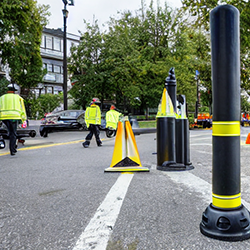Introduction
Speed humps are an effective traffic calming tool used to reduce vehicle speed in residential areas and to improve pedestrian safety. They are usually placed in areas where there is a high risk of vehicle-pedestrian collisions or speeding. Speed humps are raised surfaces on the road which are designed to slow down vehicles by forcing them to slow down as they drive over them. Although speed humps are a popular traffic calming tool, there are certain situations and places where they are not used or are ineffective. In this article, we will look at where speed humps are not used, and what scenarios they are ineffective in. We will also discuss why speed humps are not used in some places and what alternatives may be used instead. Finally, we will look at the limitations of speed humps and the possible negative effects they can have.
What are Speed Humps and How are They Used?
Speed humps are a type of roadway hump designed to reduce car speed and improve safety for pedestrians and cyclists. They are raised, flattened bumps that span the width of the road, usually placed in areas with a lot of foot and bike traffic. Speed humps are not as large as speed bumps, which are also used to reduce speed, but are much more noticeable and can be more effective in certain locations. Speed humps are typically used in areas with a higher speed limit, such as residential areas and school zones, or as a way to slow down drivers in areas with high traffic. They can also be used in conjunction with traffic lights and signs to help drivers follow the speed limit. Speed humps are usually raised 20-30 cm above the road, and are usually painted yellow or white to be visible to drivers.
Why are Speed Humps Not Used Everywhere?
Speed humps are a popular form of traffic calming, but they may not be used in certain places for a variety of reasons. For one, they may not be suitable for certain terrains and road surfaces. Additionally, the size and shape of the speed hump can cause certain issues, such as making it difficult for cyclists and motorcyclists to navigate. Furthermore, speed humps can interfere with public transport routes, as buses and other public transport vehicles may not be able to drive over them. Additionally, speed humps can be expensive to maintain, meaning they may not be suitable for certain budgets. Finally, there are potential negative effects of speed humps, such as increased noise and air pollution levels, which can be a concern for certain communities. As such, speed humps may not be used in certain locations.
What are Speed Humps Ineffective At?
Speed humps are not a perfect solution to controlling speed, and they are ineffective in certain situations. Speed humps can be ineffective in areas with high-speed traffic, as they may not be enough to slow vehicles down. Additionally, they are often ineffective in areas with high-volume traffic, as they may slow vehicles down too much, leading to traffic congestion. Speed humps can also be ineffective in areas with large vehicles, such as trucks or buses, as they may not be able to go over the humps without damage to the vehicle or to the hump itself. In addition to this, speed humps can be hazardous to cyclists and pedestrians, as they may not be able to go over them with ease.
Overall, speed humps are only effective in certain situations. They should not be used in high-speed areas, in areas with high-volume traffic, or in areas with large vehicles. They should also be used with caution in areas with cyclists and pedestrians, as they can be hazardous for them.
Conclusion
Speed humps have become a popular way to reduce traffic speeds and create safer streets for drivers and pedestrians. They are incredibly effective in areas with heavy traffic, frequent pedestrians, and especially in areas with children. However, speed humps are not effective in certain areas and should not be considered a one-size-fits-all solution for traffic speed reduction. They are also not suitable for long stretches of roads, steep hills, and intersections.
Ultimately, speed humps are a powerful way to reduce the speed of traffic but should be used with caution, as they can have negative consequences and be ineffective in certain areas. They should be implemented only when it is clear that they are an effective and safe solution for traffic speed reduction.


